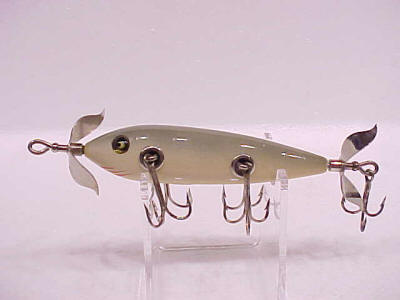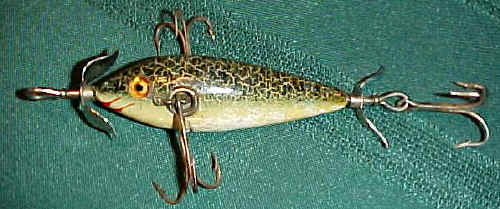By Dr. Michael Echols
Fact: Everyone has problems when grading older lures or boxes because it is totally subjective.
(Subjective: an adjective; of or resulting from the feelings of the person thinking; not objective; a personal feeling or opinion)
|
Factors which change box or lure grading Extensive article on grading boxes |
VISUAL VALUES:
Visual values vary considerably from person to person. As we all know, not everyone has good taste or appreciation for details. (What other explanation is there for people who buy ugly dogs?) Being old is no excuse for poor condition. I don't know how many times I've heard a guy lecture me on the fact that: "these lures are over 80 years old you know, so you have to expect a few chips and scrapes". And I reply, "True, sir, but the price will have to adjust accordingly for the chips and scrapes!" If you've got chips and scrapes, then we are not talking excellent condition or excellent prices.
Mint or New In The Box:
- Mint means perfect and untouched, new, unfished, no crazing, and unused.
- Mint is as new from the factory. New! No flaws whatever, even the varnish is completely clear.
- Mint is the way they looked the
day they were put in the box at the factory.
Excellent :
- Excellent means an almost new lure. It has some minor, and I do mean minor, defects like tiny pointers or a tiny varnish flake. These lures will be in almost new condition and most likely never having seen water.
- You don't have to make excuses for a lure in excellent condition.
- Excellent means there is nothing missing from the paint or varnish. The paint will be shiny and not dull. Dull dirty paint or baits exposed to gasoline will not have a glossy finish.
- With Excellent, there are no paint chips, no varnish flakes, but there may be a ring around the belly weight. Expect very minor unopened age cracks or some 'crazing' of the varnish which is exampled below.
Examples: below are two early c. 1913-1920 Shakespeare underwater minnows in absolute Excellent condition. The paint is glossy or "lipstick shiny". There is no crazing, no chips near the tail or nose prop, no hook drags, and no varnish flakes. The hardware is shiny and there is no rust. This is really into the level of Excellent plus or mint. This is what I collect...!
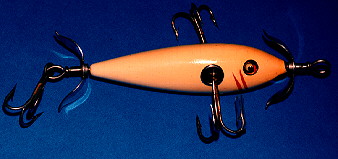
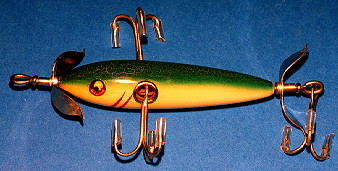
Excellent has two parts:
- An Excellent plus lure means there are no hook pointers in the paint, absolutely no hook scrapes, no paint off the belly weight, no paint chips and no varnish flakes. The paint is shiny, but there may be some age related crazing or very minor fracture cracks in the varnish or paint.
- Excellent minus allows for some minor varnish defects, but no paint loss other than maybe very, very minor chips at the tail or belly weight, and no hook drags. Hooks should be consistent with the paint finish.
Please note: Since I don't collect lures in grades less than Excellent Minus, the rest (very good, good, fair, average) is academic so I don't cover those grades in detail here, but they are covered below by example...
DEFINITIONS AND TERMS:
The following are terms and illustrations of defects which alter the grade of a lure. No one defect will set the grade, but these are the types of problems which differentiate between excellent and excellent minus or between excellent minus and very good.
-
Pointers: Marks made by the hook points as they swung around and contacted the paint or varnish at a point. Basically it's a tiny puncture hole in the paint or varnish. Commonly referred to as a 'pointer'. Pointers change the grade if there is more than a couple and those have to be minor.
|
In
the photo there is one pointer near the tail area on the black back. Depending on the extent and number, pointers are not a huge factor unless the bait is being passed as mint or excellent. The more pointers the lower the grade. Large and deep pointers like those on this red and black spotted lure can drop a grade to Very Good quickly. |
-
Flakes: Usually in reference to varnish flakes which are the result of the varnish sticking to something and being pulled off the paint, or an actual varnish chip down to, but not including the paint color. Varnish flakes can and will down-grade a lure if there are more than just a few and it also depends on the extent of the area covered by the flakes and where they occur.
|
The photo illustrates multiple (severe) varnish flaking on the belly. Flakes can be a big factor in down-grading depending on the extent. How much you count paint off the belly weight is a personal call since so many baits have this problem it almost seems the be the norm, but that is no excuse. Paint off is paint off...downgrade it. This lure would grade Below Average. |
|
The red and green spotted, five sided, Heddon series 00 below is notorious for flaked varnish due to all the sharp edges. This one is in Excellent minus or perhaps Very Good plus, plus due to a couple of light varnish rubs (lighter areas) between the cups. There is a ring around the belly weight, but no paint loss (yet!). There are no hook drags, no chips into the paint, no significant cracks. |
|
-
Crazing: Also known as 'checking', these are age induced minor fractures of the paint or varnish. Usually there is a quilted pattern to the cracks which look like brick work under a magnifying loop. This is not to be confused with deep splits of the paint which are better termed cracks.
| The photo exhibits extensive, rather than minor or micro crazing. It's a personal choice as to the effect on the grading. As it gets more extensive, it is a detriment. In older Heddons, if minor, it can be an asset to determine authenticity. |
|
-
Hook drag: a semi-circular scratch made by a hook into the paint or varnish. Hook drags are a major factor in down-grading a lure. If a bait has been fished, usually there will be hook drags.
| This example shows a semi circular mark made by the hooks as they swing around. Typically this problem quickly down-grades the condition into the Very good range. |
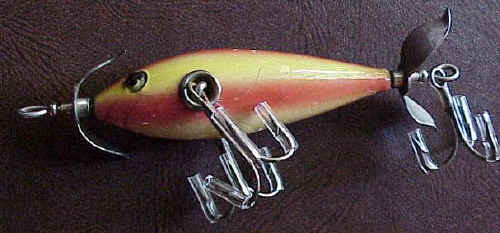 |
- Cracks: Separation of the paint or varnish down to the wood and not normal. Cracks are a source of water getting to the wood and producing swelling which causes the paint to flake or pop off in large sections.
| In this illustration, there are both age crazing and the one deep crack into the wood. This is more a personal problem than a big deal in the grading. It depends on the extent of the crack, but usually a reason to down grade the lure. |
|
-
Chip: Paint loss in varying sizes, but usually down to the wood. The chip in this green crackleback paint is typical of one down to the wood. Paint chips are the biggest single problem which will down-grade a lure. If there are paint chips down to the wood, then the lure is not going to grade much above Very Good condition.
| A chip this size starts this lure grade at very good minus and other factors might take it down further. Chips or paint loss are a very big deal in grading. You got chips down to the wood, you got problems! This chip would keep this lure in the Good range at best. |
|
-
Shiny: (a.k.a. lipstick shiny, slick, wet) A term used to describe the slick, smooth, non-dull, quality of well preserved paint which has not been subjected to chemicals or intense light. The opposite of the shiny surface would be dull, dirty, and lifeless paint as a result of exposure to chemicals, light, dirt, or use. Degree in either direction determines plus or minus grade. This is a factor you want to see on excellent grade lures.
-
Beater: a lure that is in less than Average condition. Not collectible, but useful for parts.
-
Rub: Smooth paint or varnish loss via rubbing, not a chip, not a flake, but more than likely due to rubbing against a hard object like a box top or being deeply cleaned. Depending on the extent, a factor, but not a big deal sometimes.
-
Touch-up: Typically adding new varnish, gill marks, or an attempt to match the existing antique paint with new paint to hide a defect. A no-no and automatically removes the lure from being a collectible.
-
Repaint: a lure body that has been repainted by an arts and crafts person. Not something that should be in the tackle collecting scene. If properly marked, a curiosity fit for shadow box displays used by interior decorators and walls in sports bars. Is that clear?
-
Worm burn: The result of a plastic worm being left against lure paint for an extended time. Typically the paint melts and leaves a messy goo where the worm was in contact. Causes a burn like mark similar to what a cigarette does to Formica or a laminated furniture surface. Typically earns the lure a 'hangs well' grade, but eliminates it from anything above average.
-
Stupid: What some of us get when we start rationalizing how valuable a ratty old lure is because of its age.
| Click here for an EXTENSIVE LIST of factors on lure grading |
Following are some examples of Lesser Quality lures:
Below, is a Heddon 100 that has a number of problems which would rate it as only Good to Average at best.
Problems: Large areas of varnish flakes, scrapes, pointers to the wood. When this much varnish and paint are scraped or flaked off, then you are into Average at best.
 |
This 100 has a couple of problems. Note the paint chips to the wood on the tail. The usual fine cracks are too extensive. Although 'crazing' is normal for baits this age, in this case it's too extensive.. It appears the larger cracks are deep and most likely there will be future flaking of the paint because the cracks are so large and extensive. This bait would then only grade There are multiple pointers, and flaking of the varnish. Average.
Below, is a Shakespeare 5 hook Musky as an example of a great old rare (c. 1907) bait which has been subjected to cleaning the varnish as well as some of the paint off down to the white primer. (Many Shakespeares get cleaned to the point where they become "white" lures.) There are hook drags in to the paint. It has paint off the sides, belly weight, and tail down to the wood. No matter how you grade this bait, it grades as Fair to Poor.
 |
|
EXTENSIVE LIST of factors which change box grading EXTENSIVE ARTICLE on grading boxes |
Mint--Box should look like it came off the shelf. Crisp, no dirt, corners sharp, and no wear. All lettering crisp and clear. Price tags or written price should not detract. Structure of the box must be stiff and unwarped. No water marks or sunlight fading damage.
Excellent--Box will have very minor wear to the corners and some wear around the edges. All wording and lettering should be clear. No rips or tears. Price tags or written price should not detract. Structure of the box must be stiff and unwarped. No water marks or sunlight damage.
Very Good--Box will have wear to corners and wear around edges. Box may have light soiling or light water marks. Box may have very minor tears (e.g., paper label applied that is starting to peel up) or very small dents. Some of the lettering may be slightly worn. Structure is still there, box will be square at corners and along panels. No mushyness to the side or tops.
Good--Box will have dirt, stains or water marks. Probably looks "dingy" overall. Lettering will be worn, but you should be able to read part of it. Box may have tears or repairs with tape. Structure may be distorted and joints of the box may be split. Sides of box are not straight or stiff.
Poor--Barely readable lettering. Stains, soiling, with tears or parts of the box missing (end flap, etc.). Structure is gone, box not stiff or squared. Sides, bottom or top are mushy due to water damage.
Return to AntiqueLures homepage
A FULL TOPICAL INDEX FOR ANTIQUELURES
A LIST OF ALL EARLY FISHING LURES IN THIS COLLECTION

